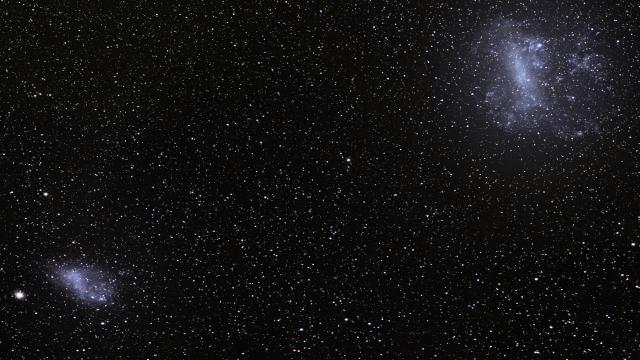Should you find yourself in the southern hemisphere beneath dark skies, look up: You’ll see two faint, glowing smudges beside the vast, glowing trail of our Milky Way galaxy. These two Magellanic Clouds are galaxies, too, though smaller ones orbiting our own.
And some time in the past, perhaps back in the dinosaur days, those two clouds may have collided.
A new study based on observations from the Gaia star map analysed the motion of stars in the Small Magellanic Cloud. The scientists found that the stars were behaving exactly as predicted in an earlier simulation, indicating a likely prior interaction with the Large Magellanic Cloud.
“This took place a hundred million years ago, but from an astronomical standpoint that’s quite recent history,” Sally Oey, an astronomy professor at the University of Michigan, told Gizmodo. “At the time that happened, it was a pretty spectacular event.”
Models of how these two dwarf galaxies previously interacted came from University of Arizona professor Gurtina Besla’s work. These models are based on observations from University of Virginia professor Nitya Kallivayalil and graduate student Paul Zivick, which showed that these dwarf galaxies are moving faster than previously thought and that they are connected by a bridge of gas.
Besla predicted that the observations would best be explained by a collision between the two galaxies in the recent past.
Since that prediction, the Hubble Space Telescope and the Gaia observatory have taken further data on these objects, including the motion of their stars. Oey was interested in the runaway blue supergiant stars in the Small Magellanic Cloud, which is broken into two distinctly moving regions — a main “bar” with a smaller “wing” to the southeast.
Runaway stars are exactly what they sound like: Stars that seem to be moving too quickly or in the wrong direction, either because of gravitational effects or because they were once in multiple-star systems where one member went supernova.
These runaway stars in the wing seemed to be moving exactly as Besla predicted, with motions pointing along the bridge between the two galaxies and pointing back to the Large Magellanic Cloud. This confirms prior work demonstrating that the Small Magellanic Cloud isn’t rotating, and parts of it are instead still acting based on the previous interaction between the two objects, according to the study published in the Astrophysical Journal Letters.
Besla was also excited about how her and Oey’s differing interests combined in this work. “She’s interested form the point of view of how binary and massive stars evolved,” said Besla. “I look at the data and say, whoa, they’re moving exactly the way we thought they should be. We were coming at this story from completely different angles.”
Other researchers thought that the observations and analysis were convincing. “The analysis also highlights the power of the kind of data that the Gaia satellite has produced: providing kinematic information of stars across the night sky in a way that wasn’t available before,” Sownak Bose, postdoctoral fellow at the Harvard-Smithsonian Center for Astrophysics’ Institute for Theory and Computation, told Gizmodo.
Bose was also excited about what the dynamics of these satellite galaxies could tell us about the Milky Way and how it assembled — which in turn could tell us about the mysterious dark matter that seems to permeate the galaxy but can’t be detected directly.
Oey will continue studying these runaway stars, while Besla has more ideas for looking at this potentially chaotic history of our two neighbours.
But this is why we build telescopes — the stories of our universe are written in the stars, so long as you look with the right equipment.
